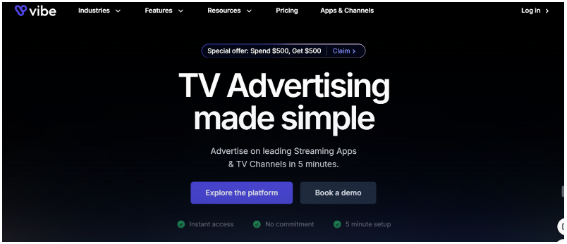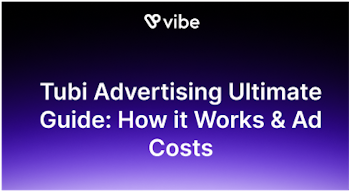Television (TV) Marketing Strategies
TV advertising isn’t dead—it’s evolving.
Television marketing strategies are still one of the most powerful ways to build brand awareness and drive sales.
But with rising costs and audience fragmentation, traditional strategies aren’t enough.
The good news? Smart advertisers are using data-driven strategies to get higher ROI from TV ads than ever before.
In this blog, I will break down 5 proven TV marketing strategies that will give you the edge.
You’ll discover not only what works, but also why these strategies will help you reach the right people, boost engagement, and track your ROI more effectively.
Here’s what you’ll learn:
By the end of this blog, you’ll have a clear picture of how to make your TV ads work smarter, not harder.
So, let’s dive in and find out how these strategies can really boost your marketing game!
1. Targeted TV Advertising: A Proven Strategy for Reaching the Right Audience
When it comes to proven television marketing strategies, targeted TV advertising is one of the most effective ways to get real results.
But, what does targeted TV advertising actually mean?
Targeted TV advertising means showing ads to people who are most likely to be interested in them. This makes ads more relevant and effective.
So, how is this different from regular TV ads? Let’s break it down:
- Traditional TV ads are shown to a wide audience, no matter who is watching. This means the ad goes to people who may or may not be interested in it.
- Addressable TV ads allow brands to send different ads to different households watching the same show. This is possible because the TV provider has data on who’s watching and can show ads based on this info.
- Programmatic TV ads are the most advanced. These ads use automated technology to place ads based on specific audience data, such as age, location, and interests. It’s like smart advertising that uses real-time data to make sure the ad gets to the right person.
By using these types of ads, businesses can use audience data to make better decisions.
For example, if a company knows that a certain age group in a specific area watches a particular TV show, they can target that group with an ad for something they’re likely to want.
This way, the ad doesn’t just reach anyone—it reaches the right people.
So, with targeted TV advertising, businesses can make sure their ads are not just seen, but noticed by the people who matter most.
2. How Storytelling in TV Ads Can Boost Engagement and Drive Results
Storytelling in TV ads is a proven strategy that can make your advertisements more memorable and effective.
When you tell a story through your ads, you connect with people on a deeper level.
This emotional connection is what makes people remember your brand and engage with your message.
How Storytelling Boosts Engagement
When you tell a story in a TV ad, something magical happens: you hold the viewer’s attention.
People are naturally drawn to stories, and they are more likely to watch an entire ad that engages them emotionally.
Here's how storytelling specifically works to boost engagement:
| Benefit | Why It Matters | Impact on Engagement |
|---|---|---|
| Keeps Viewers Interested | A compelling story grabs attention and sustains interest. | Viewers are more likely to watch the entire ad instead of skipping. |
| Creates Emotional Connections | Emotional appeal fosters a personal bond with the brand. | Leads to higher engagement and brand recall. |
| Encourages Sharing | Strong narratives inspire viewers to share with others. | Increases organic reach and word-of-mouth promotion. |
By incorporating storytelling into TV ads, brands can make a lasting impression and drive stronger audience engagement.
Examples of Brands That Used Storytelling Well
Here are a few examples of how well-known brands have successfully used storytelling in their ads, leading to strong engagement and increased results:
1. Coca-Cola – "Share a Coke" Campaign: Coca-Cola’s "Share a Coke" campaign used personalized bottles with names on them. This simple yet powerful idea encouraged people to share a Coke with a loved one, creating an emotional connection with the brand.
2. John Lewis – Christmas Advertisements: John Lewis is known for its heartwarming Christmas ads. One of their most famous ads features a little girl buying a gift for her sister. The story is about giving, love, and connection.
3. Nike – "Dream Crazier" Campaign: Nike's "Dream Crazier" ad highlights the stories of women athletes who have overcome challenges. This ad inspires viewers to push beyond their limits and is a great example of how storytelling can inspire action.
Steps to Create a Story-Driven TV Ad
Now that you’ve seen how storytelling works in ads, here’s a simple breakdown of how to create your own story-driven TV ad:
| Step | Action |
|---|---|
| Step 1 | Define Your Core Message: What do you want people to take away from your ad? Keep it simple and focused on one key message. |
| Step 2 | Create Relatable Characters: Develop characters your audience can relate to. These characters should reflect the values and emotions your brand wants to convey. |
| Step 3 | Build a Simple Narrative: Craft a story with a clear beginning, middle, and end. Make it easy to follow, but engaging enough to keep viewers interested. |
| Step 4 | Use Music and Visuals to Enhance the Emotion: Select music and visuals that match the emotional tone of your story. They should complement the narrative and deepen the emotional impact. |
| Step 5 | End with a Clear Call to Action: After the story, let viewers know exactly what you want them to do next—whether that’s visiting your website, signing up, or making a purchase. |
Storytelling helps your brand build a strong emotional connection with your audience.
When people connect with the story, they are more likely to remember your brand, engage with the message, and even share it.
This leads to higher engagement and better results, making storytelling a proven television marketing strategy.
3. How to Combine TV Ads with Digital Marketing for Better Results
Combining TV advertising with digital marketing is a proven strategy that can significantly improve your advertising efforts.
By using both traditional TV ads and digital platforms like social media, websites, and mobile apps, you can reach a broader audience, increase engagement, and drive better results for your business.
Why Connect TV Ads with Digital Marketing?
Here’s why connecting TV advertising with digital marketing is a smart strategy:
- Wider Audience Reach: TV ads are excellent for reaching a large audience, but digital marketing helps you connect with people who prefer to engage with brands online. Combining both increases your overall reach.
- Reinforced Messaging: When your brand message is seen across both TV and digital platforms, it creates a stronger, more consistent message, making it easier for your audience to remember.
- Better Tracking and Results: Unlike traditional TV ads, digital marketing allows you to track the effectiveness of your campaigns in real time, giving you valuable data to adjust strategies and improve performance.
How QR Codes, Social Media, and Digital Retargeting Improve TV Ad Performance
Integrating QR codes, social media, and digital retargeting into your TV ads boosts their effectiveness. Here's how:
- QR Codes: Adding a QR code to your TV ad allows viewers to scan it and take immediate action, like visiting your website or accessing an exclusive offer. This creates an interactive experience and helps track ad engagement.
- Social Media: Including social media handles or hashtags in your TV ads invites viewers to interact with your brand on platforms like Instagram, Twitter, and Facebook. This encourages engagement and builds brand presence across multiple channels.
- Digital Retargeting: After viewers see your TV ad, you can use digital retargeting to show them additional ads online. This increases the likelihood of conversions by keeping your brand top of mind and encouraging actions like purchases or sign-ups.
Best Practices for Combining TV Ads with Digital Marketing
| Best Practice | Action |
|---|---|
| Maintain Consistency Across Channels | Ensure your message, visuals, and tone are aligned across both TV and digital platforms. This creates a cohesive and recognizable brand experience. |
| Time Your Campaigns Together | Launch your TV and digital campaigns at the same time. This reinforces the message and increases the chances of audience recall. |
| Use Real-Time Data to Optimize | Track digital ad performance and adjust your TV ads based on the data. If a particular post or online ad is performing well, integrate it into your TV ads. |
| Include a Clear Call to Action (CTA) | Make sure your CTA is simple and clear across both TV and digital platforms. Encourage viewers to visit your website, follow on social media, or take advantage of an offer. |
4. How to Track and Measure TV Advertising Performance
Measuring your TV ad performance is key to understanding if your campaigns are delivering results.
By tracking the right metrics, you can evaluate effectiveness and make data-driven adjustments for better impact.
Here’s a breakdown of the key metrics:
| Metric | What It Measures | Why It’s Important |
|---|---|---|
| Reach & Impressions | How many people saw the ad | Measures brand visibility and how many people were exposed to the ad. |
| TV Ad Attribution | Whether the ad led to website visits or sales | Indicates if the ad is driving real business actions. |
| Engagement Rate | Viewer interaction (e.g., website visits, QR code scans) | Shows how engaging and relevant the ad is to the audience. |
| Cost Per Thousand Impressions (CPM) | The cost to reach 1,000 viewers | Helps evaluate the cost-effectiveness of your ad spend. |
| ROI (Return on Investment) | Revenue generated from the TV ad campaign | Determines the profitability of the ad campaign. |
These metrics give you a clear idea of your ad performance, making it easier to assess whether your TV ads are achieving your goals or if adjustments are needed.
Why Tracking TV Ad Performance Matters
- Optimize Campaigns: By reviewing performance metrics, you can identify what worked well and what didn’t. For example, if your engagement rate is high, but ROI is low, you may need to adjust the call to action or optimize the landing page.
- Measure Cost-Effectiveness: Knowing your CPM allows you to determine if your TV ad spend is efficient. You can adjust your budget allocation based on which time slots or channels bring in better results at a lower cost.
- Improve Strategy for Future Campaigns: With clear performance data, you can refine your targeting and improve future ad placements. For example, if certain demographics or regions perform better, you can target those areas more effectively next time.
Using Data to Optimize Future TV Campaigns
Once you have your data, use it to make informed decisions about how to improve future campaigns:
- Ad Refinement: Focus on improving elements that generate the most engagement, such as visuals, music, or message.
- Adjust Timing and Placement: If certain time slots or channels lead to higher engagement, prioritize those in your next ad run.
- Combine with Digital Strategies: If you're using digital marketing alongside TV ads, use performance data from both platforms to create a cohesive strategy. For example, retargeting viewers who interacted with your TV ad online can increase conversions.
By tracking these key metrics, you can fine-tune your strategy, ensuring that your next TV ad campaign is more effective and cost-efficient.
5. How Connected TV (CTV) and OTT Ads Improve TV Marketing
Connected TV (CTV) and Over-the-Top (OTT) ads are changing the way businesses market on TV. They offer better targeting, increased engagement, and higher ROI than traditional TV ads. Let’s break it down.
What Are CTV and OTT Ads?
Connected TV or CTV refers to TVs that connect to the internet, such as smart TVs and streaming devices like Roku or Apple TV. It allows viewers to stream content directly, without relying on traditional cable or satellite.
CTV provides a more personalized advertising experience, as it allows businesses to target specific audiences based on their interests and behaviors.
Over-the-Top or OTT refers to ads shown on streaming platforms like Netflix, Hulu, and Amazon Prime. These platforms deliver content directly over the internet, without the need for a cable subscription.
OTT platforms allow advertisers to target users who are already engaged with the content, ensuring ads are seen by interested viewers.
Why CTV Ads Offer Better Targeting and Higher ROI
| Feature | What It Offers | Why It’s Better |
|---|---|---|
| Advanced Targeting | Reach audiences based on interests, location, and behavior. | More precise targeting leads to higher engagement and less wasted ad spend. |
| Better Viewer Engagement | Ads are shown to viewers who actively choose their content. | Viewers are more likely to pay attention, leading to better results. |
| Higher ROI | Real-time data and performance insights. | Helps businesses optimize ad spending for a better return on investment. |
How Vibe.co Helps Run Effective CTV Ads

Vibe.co is a platform that helps businesses run CTV ads and target the right audience with precision.
It helps businesses run effective ad campaigns on both Connected TV (CTV) and Over-the-Top (OTT) platforms. Here’s how it works:
- Advanced Audience Targeting: Vibe.co allows businesses to target specific audiences based on interests, behavior, and location, ensuring the ads reach the right viewers whether they’re on CTV or streaming on their smartphones, tablets, or computers.
- Real-Time Performance Tracking: With Vibe.co, businesses can track ad performance in real-time, measuring how well ads are engaging the audience. This allows for quick adjustments to improve results, whether on CTV or OTT platforms.
- Seamless Integration: Vibe.co makes it easy to integrate CTV ads with OTT and other digital marketing efforts. This creates a unified strategy across all platforms, helping businesses reach a wider audience and strengthen their campaigns.
In short, Vibe.co helps businesses run smart, targeted, and effective CTV ad campaigns, making it easier to reach the right audience and track results.
What NOT to Do in TV Marketing
Avoid these common mistakes to make your TV ads more effective:
| Mistake | Why It’s a Problem | How to Fix It |
|---|---|---|
| Targeting Everyone | Generic ads waste money and don’t engage the right audience. | Use addressable TV or CTV ads to target specific viewers. |
| Not Tracking Performance | You won’t know if your ads are working. | Measure reach, engagement, and ROI with tracking tools. |
| Dull or Outdated Ads | Boring ads won’t grab attention. | Use storytelling and visuals to make ads engaging. |
| Ignoring Digital Integration | Running TV ads alone limits their impact. | Combine TV ads with social media, QR codes, and retargeting. |
| Skipping CTV & OTT Ads | Traditional TV lacks precise targeting and tracking. | Use CTV & OTT for better audience reach and data insights. |
| Weak Call to Action (CTA) | Viewers don’t know what to do next. | Include a clear CTA like visiting a website or scanning a QR code. |
| Not Adjusting Campaigns | Running the same ad without changes hurts results. | A/B test different creatives, placements, and messaging. |
Avoid these mistakes, track your results, and integrate TV with digital marketing for better engagement and higher ROI.
Conclusion
Traditional TV ads are evolving, and smart advertisers are blending them with digital strategies for maximum impact.
To wrap it up, here are the 5 proven TV marketing strategies that can really help your business:
- Targeted TV Ads: Show your ads to the right people at the right time.
- Storytelling: Make your ads fun and memorable.
- Cross-Channel Ads: Use TV and online ads together for better results.
- Track Your Ads: See how your ads are doing and make them better.
- CTV and OTT Ads: Use smart TV ads to get higher returns.
Businesses should use data and digital tools in TV advertising. This way, you can reach the right audience, track your results, and make your ads better.
If you're ready to try out better TV ads, Vibe.co can help you. It makes ads more targeted, tracks results better, and helps you get better returns. Give it a try today and see the difference!
FAQs about Television Marketing Strategies
- What is CTV and OTT advertising?
CTV (Connected TV) refers to TVs connected to the internet, like smart TVs or streaming devices (e.g., Roku, Apple TV). OTT (Over-the-Top) advertising runs on streaming platforms like Netflix, Hulu, and Amazon Prime, bypassing traditional TV. - How does CTV advertising help my business?
CTV ads allow you to target specific audiences based on their interests and viewing habits, leading to more engaged viewers and a higher return on investment (ROI). - Why is combining TV ads with digital marketing effective?
Combining TV ads with digital marketing helps you reach a wider audience and gives you better targeting. It also allows for tracking performance in real-time, making adjustments easier. - How can Vibe.co help with my CTV ad campaigns?
Vibe.co allows you to target the right audience, track ad performance in real-time, and adjust your campaigns to ensure better results. It helps integrate CTV ads with other digital strategies. - How do I track the success of my TV ads?
You can track success using metrics like reach, engagement, and ROI. These metrics give you insight into how well your ads are performing and where improvements are needed.



